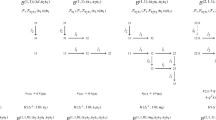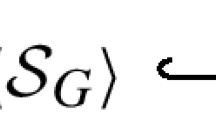Abstract
We relate the generating functions of the dimensions of the Hochschild cohomology in any fixed degree of the symmetric groups with those of blocks of the symmetric groups. We show that the first Hochschild cohomology of a positive defect block of a symmetric group is nonzero, answering in the affirmative a question of the third author. To do this, we prove a formula expressing the dimension of degree one Hochschild cohomology as a sum of dimensions of centres of blocks of smaller symmetric groups. This in turn is a consequence of a general formula that makes more precise a theorem of our previous paper describing the generating functions for the dimensions of Hochschild cohomology of symmetric groups.
Similar content being viewed by others
1 Introduction
Let p be a prime number and k a field of characteristic p. As a consequence of results in [4], using the classification of finite simple groups, if G is a finite group of order divisible by p, then \(H\!H^1(kG)\) is nonzero. It is an open question [5, Question 7.4] whether for G a finite group and B a block of kG, if the defect groups of B are non-trivial, then \(H\!H^1(B) \) is nonzero. This question has been shown to have a positive answer in some cases in [8] and [6], for instance. We prove that this question has an affirmative answer if G is a symmetric group \(\mathfrak S_n\) on n letters.
Theorem 1.1
Let B a block of \(k\mathfrak S_n \) with non-trivial defect groups. Then \(H\!H^1(B)\ne 0 \).
In fact, we give a precise formula for the dimension of the first Hochschild cohomology of a block of a symmetric group as a sum of dimensions of the centres of blocks of smaller symmetric groups (Theorem 1.2), and this easily implies Theorem 1.1.
In order to state the formula, let us recall that to each block B of \(k\mathfrak S_n \) is associated a non-negative integer \(w \leqslant \lfloor n/p\rfloor \) called the weight of B, with the property that the Sylow p-subgroups of \(\mathfrak S_{pw} \) are defect groups of B under the natural inclusion \(\mathfrak S_{pw} \leqslant \mathfrak S_n\). In particular, B has non-trivial defect groups if and only if \(w>0\). Moreover, by Theorem 7.2 of Chuang and Rouquier [3] if B and \(B'\) are blocks of possibly different symmetric groups, with the same weight, then B and \(B'\) are derived equivalent algebras, and consequently, for any \(r\geqslant 0 \), we have \(\dim _kH\!H^r (B) = \dim _kH\!H^r (B')\).
For \(w \geqslant 0 \), denote by \(B_{pw}\) the principal block of \(k\mathfrak S_{pw} \). Then \(B_{pw} \) has weight w and by the above, \(\dim _kH\!H^r (B) = \dim _kH\!H^r (B_{pw})\) for any weight w block B of a symmetric group algebra. Thus Theorem 1.1 is a consequence of the following result. For \(w \geqslant 0 \), let \(\rho (pw, \varnothing ) \) equal the number of partitions of pw with empty p-core.
Theorem 1.2
Let B be a weight w-block of a symmetric group algebra over k. If \(p=2 \), then
If \(p \geqslant 3 \), then
The proof of the above formula goes through the following theorem relating generating functions of dimensions of Hochschild cohomology of blocks of symmetric groups with those of the entire group algebra and then invoking the results of our previous paper [1]. Denote by p(n) the number of partitions of n, and by P(t) the generating function \(\sum _{n=0}^\infty p(n)t^n\). Note that \(\dim _kH\!H^0(k\mathfrak S_n )=\dim _kZ(k\mathfrak S_n)=p(n) \).
Theorem 1.3
Set \(\displaystyle Z(t)= \sum _{n=0}^\infty \dim _kZ(B_{pn})\,t^n\). For any \(r\geqslant 1 \), there exists a rational function \(\phi (t)\) (depending on p and r) with \(\phi (0)\) nonzero, such that
and
Remark 1.4
In [1], we proved that
where \(R_{p,r}(t)\) is a rational function of t. Ken Ono asked us whether \(R_{p,r}(t)\) is a rational function of \(t^p\), and Theorem 1.3 proves that this is the case, with \(R_{p,r}(t)=t^p\phi (t^p)\).
Remark 1.5
The constant coefficient of \(\phi (t)\) in Theorem 1.3 is equal to \(y_1=\dim _k(H\!H^r(B_p))\). Since \(B_p\) is derived equivalent to \(k(C_p\rtimes C_{p-1})\), we have \(y_1=\dim _k H\!H^r(k(C_p\rtimes C_{p-1}))\). An easy calculation, using the centraliser decomposition, shows that for \(r\geqslant 1\) we have \(y_1=2\) if \(r \equiv 0\) or \(-1\) modulo \(2(p-1)\) (which is in particular the case if \(p=2\)) and \(y_1=1\) otherwise. If we drop the condition \(\phi (0)\ne 0\), then the two formulas in Theorem 1.3 hold trivially for \(r=0\) with \(\phi (t)=\frac{1}{t}\).
Remark 1.6
We note that the above results do not depend on the choice of the field k. If \(k'\) is an extension field of k and B a block of \(k\mathfrak S_n\) for some positive integer n, then \(B'=k'\otimes _k B\) is a block of \(k'\mathfrak S_n\) having the same defect groups as B, and for any finite-dimensional k-algebra A we have a graded k-algebra isomorphism \(H\!H^*(k'\otimes _k A)\cong \) \(k'\otimes _k H\!H^*(A)\).
2 Proofs.
We begin with an elementary lemma.
Lemma 2.1
Let R be an integral domain and m a positive integer. If \( h(t) \in R[[t]] \) is such that \(h (t^m) \in R((t)) \) is a rational function, then h(t) is also a rational function.
Proof
Let \(h(t) = \sum _{n=0}^{\infty } h_n t^n \), \( h_n \in R\) and suppose that \(a(t), b(t) \in R[t]\) are such that
If \(h(t) =0\), then there is nothing to prove. So, we assume that \(h(t) \ne 0\). Write
for \(a_s(t), b_s(t) \in R[t]\), \( 0\leqslant s \leqslant m-1 \). Comparing coefficients of powers of t, the equality
implies the equality
for each s, \(0\leqslant s \leqslant m-1\). Choose s such that \(b_s (t) \ne 0 \). Then \(h(t) =a_s(t) /b_s(t) \) is a rational function of t. \(\square \)
Proof of Theorem 1.3
Let \(r \geqslant 1 \). For \( n\geqslant 0 \), let c(n) denote the number of p-core partitions of n and for each s, \( 0\leqslant s \leqslant p-1\), set \(C_s(t) = \sum _{n=0} ^{\infty } c(np+s) \, t^n \). For \(w \geqslant 0 \), set \(z_{pw} = \dim _k Z(B_{pw} )\) and \(y_{pw}= \dim _k H\!H^r(B_{pw})\). We use the notation
from the statement of Theorem 1.3 and we set
Note that by [3, Theorem 7.2], \(y_{pw} \) is the dimension of the degree r Hochschild cohomology of any weight w block of a symmetric group algebra. Also, recall that the ordinary irreducible characters of \(\mathfrak S_n\) are labelled by partitions of n. By the Nakayama conjecture, proved by Brauer [2] and Robinson [7], two ordinary irreducible characters of \(\mathfrak S_n\) belong to the same p-block of \(\mathfrak S_n\) if and only if the partitions labelling them have the same p-core, and consequently the set of blocks of \(k\mathfrak S_n\) is in bijection with the set of p-cores of partitions of n. Further, a block of \(k\mathfrak S_n\) has weight w if and only if the corresponding p-core is a partition of size \(n-pw\). Thus, the number of weight w blocks of \(k\mathfrak S_n \) equals \(c(n-pw) \). Since the Hochschild cohomology of a finite dimensional algebra is the direct sum of the Hochschild cohomologies of its blocks, we have that for any s with \(0\leqslant s \leqslant p-1 \), and any \(n \geqslant 0\),
and
In other words, for any s, \(0\leqslant s \leqslant p-1 \),
and
Since \(B_0 \cong k \), we have \(z_0= \dim _k Z(B_0) = 1\) and from this it follows that Z(t) is invertible in \(\mathbb {Z}[[t]]\). On the other hand, we have \(y_0= \dim _kH\!H^r(B_0) = 0 \) and \(y_1=\dim _kH\!H^r(B_p) \ne 0\) (cf. Remark 1.5). In particular, Y(t) is divisible by t but not by \(t^2\) in \(\mathbb {Z}[[t]]\). So we may define a power series in t, with nonzero constant term,
and then we have
Now,
where we have used (2.3) for the second equality and (2.4) for the third equality. On the other hand, by (2.2),
So,
Now by Theorem 1.3 of [1] we have that \(t^p \phi (t^p) \) is a rational function of t. It then follows from Lemma 2.1 that \(\phi (t)\) is a rational function of t, and by the above, \(\phi (0)\) is nonzero. \(\square \)
Proof of Theorem 1.2
By Theorem 1.2 of [1],
Note that in [1] the base field is taken to be \({\mathbb F}_p \), but the above result clearly holds as well for any field of characteristic p (cf. Remark 1.6). By Theorem 1.3 and its notation, applied with \(r=1\),
Here, note that \(h(t) \rightarrow h(t^m) \) is an injective map on \({\mathbb Z} [[t]] \). This, along with [3, Theorem7.2] proves the equations
of Theorem 1.2. The remaining equations follow from the Nakayama Conjecture, proved in [2, 7], which states that characters of a symmetric group belong to the same p-block if and only if the corresponding partitions have the same p-core, implying in particular that \(\dim _k Z(B_{pj})=\rho (pj, \varnothing )\). \(\square \)
Data availability
Data sharing not applicable to this article as no datasets were generated or analysed during the current study.
References
Benson, D.J., Kessar, R., Linckelmann, M.: Hochschild cohomology of symmetric groups and generating functions, J. Group Theory to appear
Brauer, R.: On a conjecture by Nakayama. Trans. Roy. Soc. Canada Sect. III(41), 11–19 (1947)
Chuang, J., Rouquier, R.: Derived equivalences for symmetric groups and sl2-categorification. Ann. Math. 167, 245–298 (2008)
Fleischmann, P., Janiszczak, I., Lempken, W.: Finite groups have local non-Schur centralizers. Manuscr. Math. 80(2), 213–224 (1993)
Linckelmann, M.: Finite dimensional algebras arising as blocks of finite group algebras. Contemp. Math. 705, 155–188 (2018)
Murphy, W.: The Lie algebra structure of the degree one Hochschild cohomology of the blocks of the sporadic Mathieu groups. J. Group Theor. 26(1), 161–191 (2023)
Robinson, G.D.B.: On a conjecture by Nakayama. Trans. Roy. Soc. Canada Sect. III(41), 20–25 (1947)
Todea, C.C.: Nontriviality of the first Hochschild cohomology of some block algebras of finite groups. J. Pure Appl. Algebra 227(2), 107192 (2023)
Acknowledgements
DB and RK are grateful to City, University of London for its hospitality during the research for this paper. ML acknowledges support from EPSRC grant EP/T004592/1.
Author information
Authors and Affiliations
Corresponding author
Additional information
Publisher's Note
Springer Nature remains neutral with regard to jurisdictional claims in published maps and institutional affiliations.
Rights and permissions
Open Access This article is licensed under a Creative Commons Attribution 4.0 International License, which permits use, sharing, adaptation, distribution and reproduction in any medium or format, as long as you give appropriate credit to the original author(s) and the source, provide a link to the Creative Commons licence, and indicate if changes were made. The images or other third party material in this article are included in the article’s Creative Commons licence, unless indicated otherwise in a credit line to the material. If material is not included in the article’s Creative Commons licence and your intended use is not permitted by statutory regulation or exceeds the permitted use, you will need to obtain permission directly from the copyright holder. To view a copy of this licence, visit http://creativecommons.org/licenses/by/4.0/.
About this article
Cite this article
Benson, D., Kessar, R. & Linckelmann, M. Hochschild cohomology of symmetric groups and generating functions, II. Res Math Sci 10, 20 (2023). https://doi.org/10.1007/s40687-023-00382-2
Received:
Accepted:
Published:
DOI: https://doi.org/10.1007/s40687-023-00382-2




